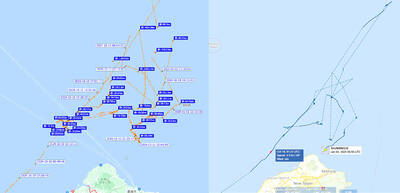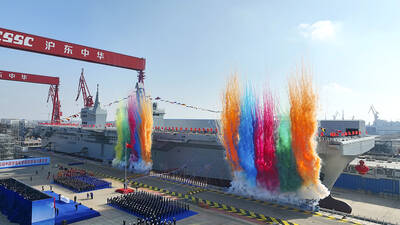The Environmental Protection Administration said yesterday that Taiwan has received NT$61.3 million in compensation for the cleanup of an oil spill, caused last year by the Greek-registered MV Amorgos. The payment marks the first time the nation has received compensation for marine pollution.
The compensation is for the cleanup only and does not include damages or lawyers' fees.
"The real battle has just begun. We will continue to demand around NT$900 million in compensation [for damages] from the insurance company," said EPA administrator Hau Lung-bin (郝龍斌) at a press conference yesterday.
"We have no doubt that the polluters will pay the price," Hau said.
Yesterday's sum was the result of long-term negotiations between Taiwan and the ship's insurance company, the Assuranceforeningen Gard-Gjensidig.
The EPA's estimate of the money spent on cleaning up the spill -- based on reports from different agencies, including the Ministry of National Defense, the Ministry of Transportation and Communications, the Council of Agriculture, the Construction and Planning Administration and the Pingtung County Government -- came to about NT$93 million.
Coordinated by the International Tanker Owners Pollution Federation Ltd (
The EPA said the difference in the compensation paid and the EPA's original estimate could be attributed to differing views between the two parties over unit prices for various aspects of the clean up.
Hau said that seeking compensation for damages would be more challenging than for the cleanup because the losses are more difficult to estimate. Hau said he hopes to receive the compensation by the end of this year.
"I have to say that money cannot make up for damaged environment," Hau said, adding that if no conclusion is made by this year, Taiwan might file a lawsuit in Norway, where the insurance company is registered.
As for losses to the fishing industry, EPA officials said that the Pingtung District Fishermen's Association had decided to seek compensation on its own and not through governmental channels.
On Jan. 14 last year, the MV Amorgos, on its way from Indonesia to China, ran aground near Kenting National Park in Pingtung County due to bad weather. Four days later, 1,150 tonnes of fuel oil remaining on the ship began to spill and contaminated 6,987m2 of the coastal area within the Lungkeng Ecological Conservation Preservation Area.
The wreck of the Amorgos is still at the bottom of waters off Kenting. The original wreck-removal plan was deemed unfeasible after it broke up and sank after typhoons last summer.
The Ministry of Transportation and Communications has not yet decided as to whether a new wreck-removal plan should be pursued.
Ministry officials said that the remains pose no environmental risk, because the ship's fuel oil and cargo of iron ore have already been removed.

A strong continental cold air mass and abundant moisture bringing snow to mountains 3,000m and higher over the past few days are a reminder that more than 60 years ago Taiwan had an outdoor ski resort that gradually disappeared in part due to climate change. On Oct. 24, 2021, the National Development Council posted a series of photographs on Facebook recounting the days when Taiwan had a ski resort on Hehuanshan (合歡山) in Nantou County. More than 60 years ago, when developing a branch of the Central Cross-Island Highway, the government discovered that Hehuanshan, with an elevation of more than 3,100m,

Taiwan’s population last year shrank further and births continued to decline to a yearly low, the Ministry of the Interior announced today. The ministry published the 2024 population demographics statistics, highlighting record lows in births and bringing attention to Taiwan’s aging population. The nation’s population last year stood at 23,400,220, a decrease of 20,222 individuals compared to 2023. Last year, there were 134,856 births, representing a crude birth rate of 5.76 per 1,000 people, a slight decline from 2023’s 135,571 births and 5.81 crude birth rate. This decrease of 715 births resulted in a new record low per the ministry’s data. Since 2016, which saw

SECURITY: To protect the nation’s Internet cables, the navy should use buoys marking waters within 50m of them as a restricted zone, a former navy squadron commander said A Chinese cargo ship repeatedly intruded into Taiwan’s contiguous and sovereign waters for three months before allegedly damaging an undersea Internet cable off Kaohsiung, a Liberty Times (sister paper of the Taipei Times) investigation revealed. Using publicly available information, the Liberty Times was able to reconstruct the Shunxing-39’s movements near Taiwan since Double Ten National Day last year. Taiwanese officials did not respond to the freighter’s intrusions until Friday last week, when the ship, registered in Cameroon and Tanzania, turned off its automatic identification system shortly before damage was inflicted to a key cable linking Taiwan to the rest of

China’s newest Type-076 amphibious assault ship has two strengths and weaknesses, wrote a Taiwanese defense expert, adding that further observations of its capabilities are warranted. Jiang Hsin-biao (江炘杓), an assistant researcher at the National Defense and Security Research, made the comments in a report recently published by the institute about the Chinese Communist Party’s (CCP) military and political development. China christened its new assault ship Sichuan in a ceremony on Dec. 27 last year at Shanghai’s Hudong Shipyard, China’s Xinhua news agency reported. “The vessel, described as the world’s largest amphibious assault ship by the [US think tank] Center for Strategic and International